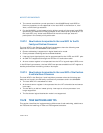
Vol. 3 19-33
ARCHITECTURE COMPATIBILITY
19.28.1 P6 Family and Pentium Processor TSS
When the virtual mode extensions are enabled (by setting the VME flag in control
register CR4), the TSS in the P6 family and Pentium processors contain an interrupt
redirection bit map, which is used in virtual-8086 mode to redirect interrupts back to
an 8086 program.
19.28.2 TSS Selector Writes
During task state saves, the Intel486 processor writes 2-byte segment selectors into
a 32-bit TSS, leaving the upper 16 bits undefined. For performance reasons, the P6
family and Pentium processors write 4-byte segment selectors into the TSS, with the
upper 2 bytes being 0. For compatibility reasons, code should not depend on the
value of the upper 16 bits of the selector in the TSS.
19.28.3 Order of Reads/Writes to the TSS
The order of reads and writes into the TSS is processor dependent. The P6 family and
Pentium processors may generate different page-fault addresses in control register
CR2 in the same TSS area than the Intel486 and Intel386 processors, if a TSS
crosses a page boundary (which is not recommended).
19.28.4 Using A 16-Bit TSS with 32-Bit Constructs
Task switches using 16-bit TSSs should be used only for pure 16-bit code. Any new
code written using 32-bit constructs (operands, addressing, or the upper word of the
EFLAGS register) should use only 32-bit TSSs. This is due to the fact that the 32-bit
processors do not save the upper 16 bits of EFLAGS to a 16-bit TSS. A task switch
back to a 16-bit task that was executing in virtual mode will never re-enable the
virtual mode, as this flag was not saved in the upper half of the EFLAGS value in the
TSS. Therefore, it is strongly recommended that any code using 32-bit constructs
use a 32-bit TSS to ensure correct behavior in a multitasking environment.
19.28.5 Differences in I/O Map Base Addresses
The Intel486 processor considers the TSS segment to be a 16-bit segment and wraps
around the 64K boundary. Any I/O accesses check for permission to access this I/O
address at the I/O base address plus the I/O offset. If the I/O map base address
exceeds the specified limit of 0DFFFH, an I/O access will wrap around and obtain the
permission for the I/O address at an incorrect location within the TSS. A TSS limit
violation does not occur in this situation on the Intel486 processor. However, the P6
family and Pentium processors consider the TSS to be a 32-bit segment and a limit
violation occurs when the I/O base address plus the I/O offset is greater than the TSS
limit. By following the recommended specification for the I/O base address to be less


















